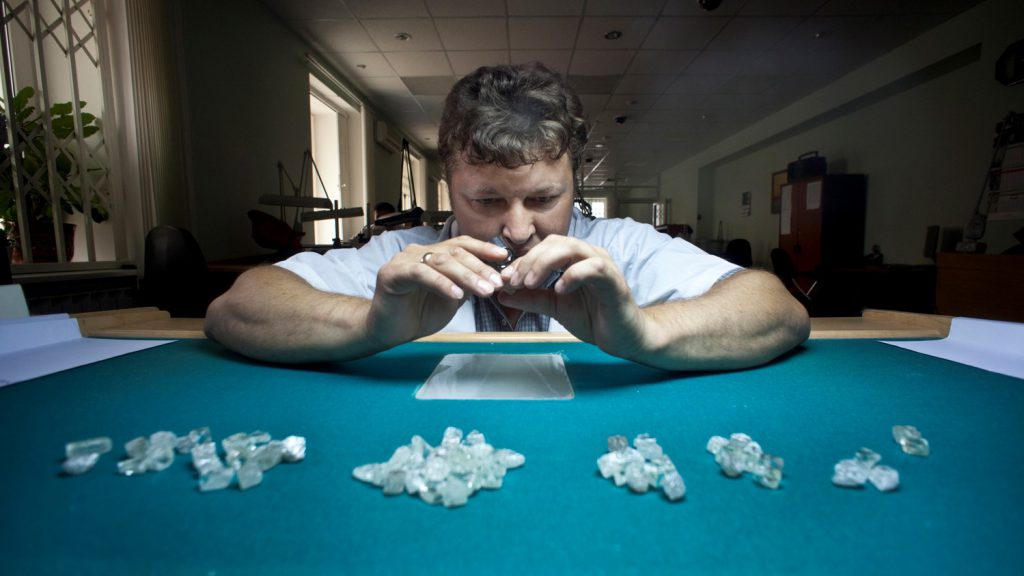
The panic that gripped the diamond world this year is starting to unwind as sanctioned Russian mining giant Alrosa PJSC has quietly revived exports to near pre-war levels.
Alrosa accounts for about a third of global rough-diamond supply, and the $80 billion industry was thrown into turmoil as cutters, polishers and traders hunted for ways to keep buying from Russia while their banks couldn’t or wouldn’t finance payments. The sudden shortage of stones sent diamond prices surging, especially for the smaller and cheaper gems that Alrosa specializes in.
Now, after months of paralysis when it was hit with US sanctions, Alrosa is back selling more than $250 million of diamonds a month, with sales currently only about $50 to $100 million a month below pre-war levels, according to people familiar with the matter. The sales have restarted as some Indian banks become more comfortable with how to facilitate transactions in currencies other than US dollars, said the people, who asked not to be identified discussing private information.
Most of the Russian stones are heading to manufacturers in India — the biggest among a handful of industry hubs, where hundreds of mostly family-owned businesses cut and polish rough stones into the finished products, ready to be used in earrings and engagement rings. Alrosa has been selling diamonds to buyers in India and Europe, mostly in exchange for rupees, the people said.
There is no indication that any sales have breached sanctions or laws. But there is still a widespread unease about the implications of dealing in Russian goods, said the people. The deals are being done quietly — even by the closed-doors standards of the famously secretive diamond world — and Alrosa has stopped publishing any information on its sales or financial performance.
A spokesperson for Alrosa declined to comment.
The return of one of the world’s main sources of precious gems will be a relief to the manufacturers and traders who rely on its stones. However, rough-diamond prices were already showing signs of softening in response to a worsening economic outlook, and the increased supply is adding further weakness.
The restarted sales show how buyers of Russian products, from oil and gas to coal and aluminum, have found ways to keep its raw materials flowing despite the fallout from the war.
For the diamond trade, there is a bigger reputational threat as well. If consumers want to avoid Russian diamonds they may simply stop buying altogether as the nature of the industry means it’s hard to keep track of any specific stone, with millions of interchangeable gems flowing between dozens of traders and manufacturers before eventually ending up in the display window of a jewelry store.
Some parts of the diamond industry have been pushing to exclude Russian production — US jewelers Tiffany & Co. and Signet Jewelers Ltd. have said they will stop buying new diamonds mined in Russia, while countries including the US have sought to have the gems labeled as “conflict diamonds,” the New York Times reported.
However, Indian and Belgian buyers and jewelry retailers from key markets such as China and the Middle East remain keen to buy Russian diamonds, and have been seeking solutions after banks became unable or unwilling to process payments once the sanctions hit.
Alrosa is effectively state controlled: the federal government owns 33% and another 25% is held by local authorities. The company competes globally with De Beers, owned by Anglo American Plc, and the two companies produce about the same amount of diamonds annually.
After the initial chaos in the wake of the US sanctions on Alrosa, the fresh flow of Russian gems is quickly easing tightness in the market.
In recent months, accredited De Beers buyers could make a profit of about 10% by trading their purchases to other gem manufacturers facing tight supplies.
Now, prices for some goods in the “secondary” market — where traders and manufacturers sell among themselves — have fallen sharply in the past month and that margin has now disappeared, the people said.
De Beers held prices steady at its latest sale last week, and with the steep correction in market prices that discount has now evaporated, removing most profit margins for its buyers, the people said.
Comments